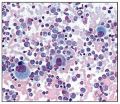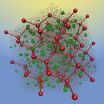(Press-News.org) Researchers at the University of California, San Diego School of Medicine have discovered that hard-to-reach, drug-resistant leukemia stem cells (LSCs) that overexpress multiple pro-survival protein forms are sensitive – and thus vulnerable – to a novel cancer stem cell-targeting drug currently under development.
The findings, published in the January 17 online issue of Cell Stem Cell, open the possibility that diseases like chronic myeloid leukemia (CML) and some solid tumor cancers might – in combination with other therapies – be more effectively treated with this drug, and with a lower chance of relapse.
Led by principal investigator Catriona H. M. Jamieson, MD, PhD, associate professor of medicine and director of stem cell research at UC San Diego Moores Cancer Center, the researchers found that a compound called sabutoclax appears to selectively target LSCs that express particular protein isoforms through alternatively splicing, a fundamental process in which a gene is able to code for multiple proteins.
An emerging class of drugs called tyrosine kinase inhibitors (TKI) – such as imitinib (Gleevec), gifitinib (Iressa) and sunitinib (Sutent) – has become a popular anti-cancer treatment. However, current TKIs are not 100 percent effective. In cases of CML, for example, some LSCs tucked protectively within bone marrow elude destruction, develop resistance to therapy, self-renew and eventually cause the leukemia to dramatically return.
Jamieson and colleagues found that alternative splicing of BCL2 genes, which code for proteins involved in apoptosis or programmed cell death, specifically promoted malignant transformation of dormant white blood cell precursors into "blast crisis" LSCs. The blast crisis is the final phase of CML when overabundant, abnormal white blood cells crowd out healthy cells, causing serious dysfunction.
Of clinical importance, they noted that sabutoclax, which suppresses all BCL2 anti-apoptotic proteins, renders these marrow-dwelling blast crisis LSCs sensitive – and more susceptible – to TKI-based therapeutics at doses that do not harm normal progenitor cells.
"Our findings show that pan-BCL2 inhibition will be critical for the eradication of cancer stem cells in CML and that there is an essential link between cancer stem cell dormancy, pro-survival BCL2 isoform expression and therapeutic resistance," Jamieson said. "By using a novel pan-BCL2 inhibitor, we may be able to prevent therapeutic resistance by sensitizing malignant stem cell clones to TKIs."
The findings may have implications for treating solid tumor cancers, such as colon, prostate, breast, and brain cancers, noted Daniel J. Goff, the study's first author.
"With many of these tumor types being shown to harbor cancer stem cells, it raises the question of whether BCL2 family expression as well as isoform-switching may be crucial for the maintenance of cancer stem cells in these diseases as well," he said. "If so, they may also be candidates for treatment with a BCL2 inhibitor like sabutoclax."
INFORMATION:
Co-authors are Angela Court Recart, Anil Sadarangani, Heather Leu, Janine Low-Marchelli, Wenxue Ma, Alice Y. Shih, Ifat Geron, Minya Pu, Lei Bao, Ryan Chuang, Larisa Balaian, Peggy Wentworth, Kristen M. Smith, Christina A.M. Jamieson, Sheldon R. Rorris and Karen Messer, UCSD Department of Medicine and UCSD Moores Cancer Center; Hye-Jung Chun and Marco Marra, Michael Smith Genome Sciences Center, Vancouver, BC, Canada; Christian L. Barrett and Kelly A. Frazer, UCSD Department of Pediatrics; Maryla Krajewska, Jun Wei, Dayong Zhai, Maurizio Pellecchia and John C. Reed, Sanford-Burnham Medical Research Institute; Jason Gotlib, Stanford Medical Center; Mark Minden, Princess Margaret Hospital, Toronto, Canada; Giovanni Martinelli, Institute of Hematology and Medical Oncology, University of Bologna, Italy; Jessica Rusert and Lawrence S.B. Goldstein, UCSD Department of Cellular and Molecular Medicine and Howard Hughes Medical Institute; Kim-Hien Dao, Oregon Health and Science University, Portland; Kamran Shazand and Thomas J. Hudson, Ontario Institute for Cancer Research, Toronto, Canada.
Funding for this research was provided by a California Institute for Regenerative Medicine (CIRM) early Translational II grant (TR2-1789), a CIRM HALT leukemia disease team grant (DR1-01430), the UCSD CIRM Training Grant (TG2-01154), the Ratner Family Foundation, the National Cancer Institute (CA-55164), the National Institutes of Health (CA-149668), the Ontario Institute for Cancer Research, Genome Canada, Ontario Genomics Institute and the Canadian Institute of Health Research.
Drug targets hard-to-reach leukemia stem cells responsible for relapses
2013-01-17
ELSE PRESS RELEASES FROM THIS DATE:
Mount Sinai researchers discover how the flu virus tells time
2013-01-17
Scientists have discovered that that the flu virus can essentially tell time, thereby giving scientists the ability to reset the virus' clock and combat it in more effective ways. According to researchers at the Icahn School of Medicine at Mount Sinai, the flu knows how much time it has to multiply, infect other cells, and spread to another human being. If it leaves a cell too soon, the virus is too weak. If it leaves too late, the immune system has time to kill the virus.
The finding provides a novel design platform for the flu vaccine and could lead to new antiviral ...
Deodorants: Do we really need them?
2013-01-17
New research shows that more than 75 per cent of people with a particular version of a gene don't produce under-arm odour but use deodorant anyway.
The study was based on a sample of 6,495 women who are part of the wider Children of the 90s study at the University of Bristol. The researchers found that about two per cent (117 out of 6,495) of mothers carry a rare version of a particular gene (ABCC11), which means they don't produce any under-arm odour.
While about 5 per cent of people who produce an odour do not use deodorant, more than a fifth (26 out of 117) of ...
Gastric banding an effective long-term solution to obesity
2013-01-17
Laparoscopic adjustable gastric banding – lap banding – is a safe and effective long-term strategy for managing obesity, according to the findings of a landmark 15-year follow-up study of patients treated in Australia.
The follow-up study, the longest and most comprehensive yet reported, was published in the Annals of Surgery, and found a significant number of lap band patients maintained an average weight loss of 26 kilograms for more than a decade after their procedure.
Professor Paul O'Brien and colleagues from the Centre for Obesity Research and Education (CORE) ...
'Jet-lagged' fruit flies provide clues for body clock synchronisation
2013-01-17
New research led by a team at Queen Mary, University of London, has found evidence of how daily changes in temperature affect the fruit fly's internal clock.
"A wide range of organisms, including insects and humans, have evolved an internal clock to regulate daily patterns of behaviour, such as sleep, appetite, and attention," explains Professor Ralf Stanewsky, senior study author from Queen Mary's School of Biological and Chemical Sciences.
"Research on animal and human clocks shows that they are fine tuned by natural and man-made time cues, for example the daily ...
Genetic admixture in southern Africa
2013-01-17
This press release is available in German.
An international team of researchers from the MPI for Evolutionary Anthropology in Leipzig and the CNRS in Lyon have investigated the maternally inherited mitochondrial DNA of 500 individuals from southern Africa speaking different Khoisan and Bantu languages. Their results demonstrate that Khoisan foragers were genetically more diverse than previously known. Divergent mtDNA lineages from indigenous Khoisan groups were incorporated into the genepool of the immigrating Bantu-speaking agriculturalists through admixture, and have ...
Study of cancer cell metabolism yields new insights on leukemia
2013-01-17
University of Rochester Medical Center scientists have proposed a new reason why acute myeloid leukemia, one of the most aggressive cancers, is so difficult to cure: a subset of cells that drive the disease appear to have a much slower metabolism than most other tumors cells.
The slower metabolism protects leukemia cells in many important ways and allows them to survive better – but the team also found an experimental drug tailored to this unique metabolic status and has begun testing its ability to attack the disease, URMC researchers report in the Jan. 17, 2013, online ...
Bacteria's hidden skill could pave way for stem cell treatments
2013-01-17
A discovery about the way in which bugs spread throughout the body could help to develop stem cell treatments.
Researchers at the University of Edinburgh have found that bacteria are able to change the make-up of supporting cells within the nerve system, called Schwann cells, so that they take on the properties of stem cells.
Because stem cells can develop into any of the different cell types in the body – including liver and brain cells – mimicking this process could aid research into a range of degenerative conditions.
Scientists made the discovery studying ...
RUB researchers find over active enzyme in failing hearts
2013-01-17
A certain enzyme, the CaM kinase II, keeps the cardiac muscle flexible. By transferring phosphate groups to the giant protein titin, it relaxes the muscle cells. This is reported by researchers led by Prof. Dr. Wolfgang Linke of the Institute of Physiology at the Ruhr Universität in the journal Circulation Research. In failing hearts, which don't pump enough blood around the body, the scientists found an overly active CaM kinase II. "The phosphorylation of titin could be a new starting point for the treatment of heart failure" Prof. Linke speculates.
Titin phosphorylation ...
Soft Lego built in the computer
2013-01-17
In developing these novel self-assembling materials, postdoc Barbara Capone has focused on the design of organic and inorganic building blocks, which are robust and can be produced at large scale. Capone has put forward, together with her colleagues at the Universities of Vienna and Mainz, a completely new pathway for the construction of building blocks at the nanoscale.
"Soft Lego" orders in crystal structures
The team of researchers has shown that so-called block copolymer stars – that means polymers that consist of two different blocks and they are chemically ...
Vaginal delivery is the safest option for women with pelvic girdle pain
2013-01-17
Caesarean section increases the risk of persistent pelvic girdle pain after delivery compared with vaginal delivery, according to a new study from the Norwegian Institute of Public Health.
Caesarean section rates are increasing worldwide, and this trend has partly been explained by women's requests for planned caesarean section without a medical reason. Pregnancy-related pelvic girdle pain has been associated with increased preference for caesarean section and with increased planned caesarean section rates.
"Some women with severe pelvic girdle pain might fear that ...


